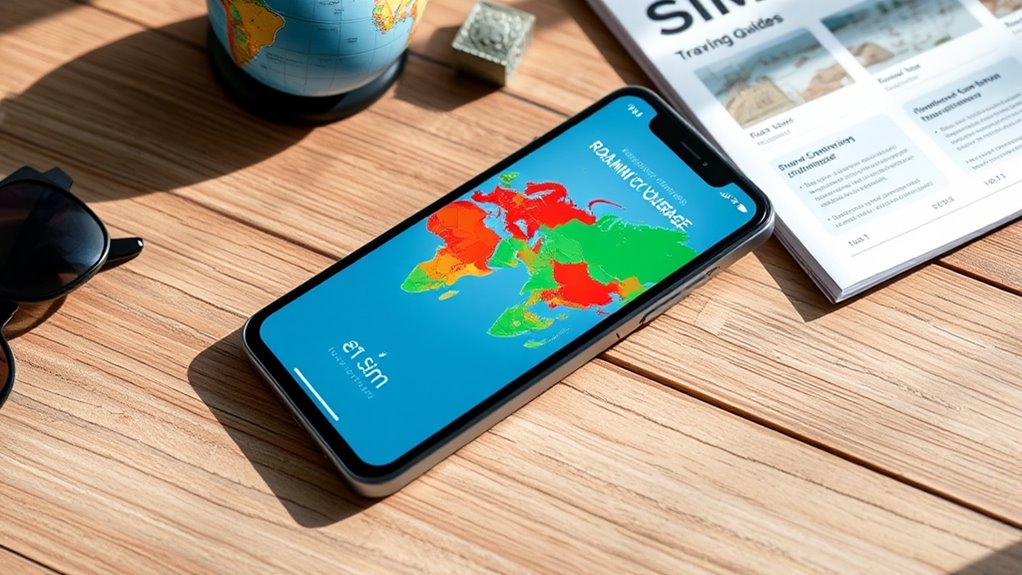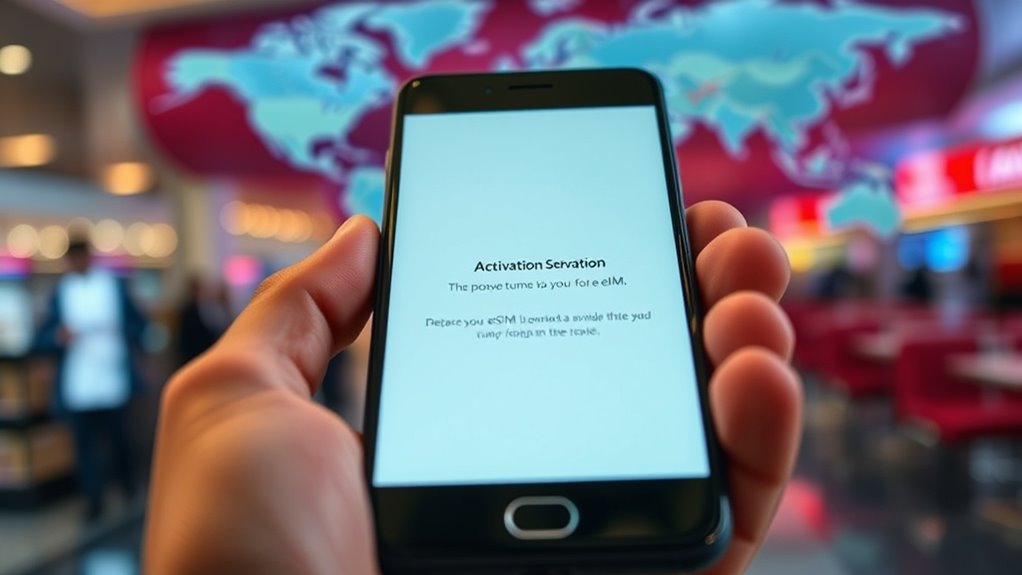To avoid eSIM roaming pitfalls, review your provider’s policies and coverage zones before traveling. Make certain your device supports local network bands and that roaming is enabled for the destination. Monitor your data usage closely and set caps to prevent unexpected charges. Activate your eSIM properly upon arrival and troubleshoot connectivity issues quickly by switching networks or restarting your device. Staying informed and prepared helps you save costs and stay connected—learn more tips to travel worry-free.
Key Takeaways
- Verify eSIM compatibility with local networks and ensure your device supports required bands before traveling.
- Check roaming agreements and coverage zones to avoid unexpected connectivity issues abroad.
- Monitor data usage regularly and set caps to prevent high charges from unintended overuse.
- Update device software and carrier settings before departure to ensure seamless eSIM activation and compatibility.
- Be aware of roaming fees and consider local data plans or additional packages to minimize costs.
Understanding Your Esim Provider’S Roaming Policies

To make the most of your eSIM while roaming, it’s essential to understand your provider’s policies. Start by reviewing their roaming agreements and coverage zones. Some providers restrict roaming to specific countries or regions, so check if your destination is included. Be aware of any additional charges or fees for roaming services—these can quickly add up if you’re not careful. Also, understand how your provider handles data, calls, and texts abroad. Some plans include free or discounted rates, while others require separate international packages. Knowing these details helps you avoid unexpected expenses and ensures seamless connectivity. Contact your provider if any policies are unclear or if you need adjustments before traveling. Being informed safeguards you money and prevents unnecessary frustrations while roaming. Additionally, understanding roaming policies can help you avoid the dangers of unexpected costs and connectivity issues during your trip.
Ensuring Network Compatibility Before Traveling

Before you travel, make certain your device supports the network bands used in your destination country. Confirm that your provider has roaming agreements with local carriers to avoid connectivity issues. Taking these steps guarantees your eSIM works smoothly when you arrive. Additionally, verifying network compatibility with your device ensures seamless connectivity in your new location.
Check Network Bands
Ensuring your device supports the network bands used in your destination country can prevent unexpected connectivity issues. If your device doesn’t support the right bands, you might find yourself without service or experiencing slow data speeds. To avoid this, check your device’s specifications and compare them with the local network bands. Here are three key points to consider:
- Identify the country’s primary network bands by researching local carriers’ frequencies.
- Verify your device’s supported bands in the manufacturer’s specifications or settings.
- Test your device abroad before your trip, if possible, to ensure compatibility.
- Stay informed about potential regulatory compliance changes that might affect network compatibility or roaming services.
Confirm Roaming Agreements
Verifying that your mobile provider has roaming agreements with carriers in your destination country can save you from unexpected connectivity issues. Contact your provider or check their website to confirm coverage in the area you’ll visit. Some providers have partnerships with local carriers, ensuring smoother service and better compatibility. Without these agreements, you might face limited coverage, high roaming charges, or no service at all. It’s also helpful to ask about specific plans or packages designed for international roaming to avoid surprise costs. Double-check that your eSIM profile is set up correctly with the right carrier details. Being aware of the industry transformations related to network compatibility can help you better understand the importance of these agreements. By confirming roaming agreements beforehand, you reduce the risk of connectivity problems and ensure a seamless experience during your trip.
Managing Data Limits and Avoiding Overcharges

Managing your data limits while roaming is essential to avoid unexpected charges. You don’t want to be surprised by hefty bills, so stay proactive. First, set a data cap through your device settings or carrier app. This prevents you from accidentally exceeding your limit. Second, monitor your data usage regularly—most apps provide real-time updates, so check often. Third, consider purchasing a local data package or roaming plan before traveling; this often offers better rates and limits. Staying aware of your consumption helps you avoid overage fees. Remember, data can quickly add up when streaming, browsing, or downloading files abroad. Additionally, understanding the role of cookies and how they track your online activity can help you manage your privacy while using data-intensive services and optimize your browsing experience. By taking these steps, you keep control over your costs and enjoy your trip without financial stress.
Activating Your Esim Properly in New Regions

Before using your eSIM in a new region, make sure it’s compatible with local networks. Then, enable roaming settings on your device to avoid service interruptions. Finally, confirm that you have network access to stay connected without hassle. Ensuring proper network compatibility can prevent many common issues associated with eSIM activation in unfamiliar regions.
Check Regional Compatibility
When activating your eSIM in a new region, it’s essential to confirm that your device and carrier support regional compatibility. Not all eSIMs work seamlessly everywhere, and some carriers may have restrictions. To avoid issues, check these key points:
- Verify your device’s compatibility with regional networks to ensure it can connect locally.
- Confirm that your carrier offers eSIM support in the area you’re visiting.
- Review any regional restrictions or requirements, such as specific carrier profiles or firmware updates.
- Consider the 4G and 5G network support of your device, as newer technologies often have broader regional compatibility.
Doing this research ahead of time helps prevent activation failures and connectivity problems. Ensuring compatibility saves you time and frustration, letting you enjoy seamless service while abroad. Always double-check before traveling to avoid surprises when you need your eSIM most.
Enable Roaming Settings
After confirming your device and carrier support regional networks, the next step is to enable roaming settings to use your eSIM effectively abroad. Access your device’s mobile network or cellular settings, then locate the roaming option. Turn on or toggle the roaming feature to allow your device to connect to foreign networks. Some devices may have an automatic roaming setting, so ensure it’s activated. If your carrier offers a dedicated app or portal, check for specific instructions on enabling roaming features. Keep in mind that enabling roaming doesn’t guarantee connectivity; it simply allows your device to search for available networks once you’re in a new region. Double-check that roaming is active before you arrive, so you’re not caught without service when you need it most. Using an Eye Patch can also help maintain a fresh and rested appearance during your travels.
Confirm Network Access
To guarantee your eSIM connects properly in new regions, you need to actively confirm network access once you arrive. This step ensures your device recognizes the local network and avoids connectivity issues. First, check your device’s signal indicator to see if it displays a carrier name or bars. Second, navigate to your network settings and manually select the local carrier if automatic connection doesn’t occur. Third, try making a test call or sending a message to verify your connection is working smoothly. If you encounter problems, restart your device or toggle airplane mode on and off. Confirming network access promptly helps you avoid surprises and ensures seamless connectivity during your travels. Additionally, being aware of potential cybersecurity vulnerabilities during roaming can help you safeguard your device from threats.
Recognizing and Troubleshooting Network Connection Issues

Network connection issues during eSIM roaming can be frustrating, but recognizing the signs early helps in resolving them quickly. If your device shows no signal, fluctuates between bars, or can’t access data, these are clear indicators of a problem. Check your network settings to guarantee roaming is enabled and your device is set to automatic network selection. Sometimes, switching to manual network selection and choosing a different carrier can resolve connectivity issues. Restart your device to refresh the connection. Verify if your SIM profile is active and correctly configured. If problems persist, contact your provider to confirm there are no outages or account restrictions. Addressing these issues promptly prevents prolonged downtime and ensures you stay connected while roaming. Additionally, understanding the cost factors associated with home security systems can help you choose a plan that fits your budget and needs.
Keeping Track of Roaming Charges and Usage

Monitoring your roaming charges and usage helps prevent unexpected bills and guarantees you stay within your budget. To do this effectively, keep an eye on your data, calls, and texts regularly. Here are three ways to stay informed:
- Check your carrier’s app or online dashboard daily to monitor usage in real-time.
- Set usage alerts or limits to receive notifications when you approach your plan’s cap.
- Review your bills carefully after each billing cycle to spot any unexpected charges or discrepancies.
Staying proactive ensures you catch any spikes in usage early and avoid surprises. Regular monitoring helps you manage your expenses, adjust your habits if needed, and enjoy your trip without financial stress.
Preparing for Emergency Situations With Alternative Connectivity Options

Emergencies can strike unexpectedly, leaving you cut off from your primary connectivity. To stay prepared, always have alternative options ready. Consider carrying a portable Wi-Fi hotspot or an offline map app that doesn’t require internet access. Keep a list of local Wi-Fi hotspots or public networks you can access if cellular service is unavailable. Stock a basic emergency kit with a backup power bank or extra batteries for your devices. Download critical documents, contacts, and maps beforehand so you can access them offline. If you’re traveling internationally, consider a local SIM card or a global roaming plan as backups. Being proactive guarantees you stay connected during crises, allowing you to call for help, navigate unfamiliar areas, or communicate with loved ones without relying solely on your primary eSIM plan.
Staying Updated on Software and Carrier Settings

Keeping your device’s software and carrier settings up to date is essential for seamless eSIM roaming. Updates often include critical security patches, bug fixes, and improvements that guarantee your device communicates correctly with networks abroad. To stay current, regularly check for updates and install them promptly.
Keep your device updated to ensure smooth eSIM roaming and secure network connections abroad.
Here are three key steps:
- Enable automatic updates to receive the latest software releases without delay.
- Check for carrier settings updates in your device’s settings menu, especially before traveling.
- Restart your device after updates to ensure changes are applied correctly.
Frequently Asked Questions
Can I Use Esim Roaming Without a Data Plan?
You might wonder if you can use eSIM roaming without a data plan. The truth is, most carriers require an active data plan for roaming, as it enables your device to connect to networks abroad. Without a data plan, your eSIM likely won’t function for internet access. However, you can still make calls or send texts if those services are included in your plan. Always check with your provider before traveling.
What Are Common Signs of Esim Roaming Issues?
You notice your eSIM roaming issues when your data suddenly drops, calls fail to connect, or messages don’t send. You might also see unexpected charges or a lack of network signal in roaming zones. These signs indicate possible problems with your eSIM roaming setup. To avoid frustration, check your plan, make sure proper activation, and verify network compatibility before traveling. Recognizing these signs helps you troubleshoot quickly and stay connected seamlessly.
How Does Esim Roaming Affect Battery Life?
When you use eSIM roaming, your device constantly searches for networks abroad, which can drain your battery faster. The roaming process requires more power as your phone scans and connects to unfamiliar networks, especially if the signal is weak. To conserve battery life, limit roaming usage when possible, turn off data or disable roaming features when not needed, and keep your device updated to optimize power management.
Is Esim Roaming Available in All Countries?
You might think eSIM roaming is available everywhere, but that’s not the case. While it’s expanding rapidly, some countries and networks still lack support. You’ll find it works seamlessly in many popular destinations, yet in others, you’ll need to rely on traditional SIM cards or Wi-Fi. Always verify your carrier’s coverage and compatibility beforehand to avoid surprises and ensure smooth connectivity wherever you travel.
Can I Switch Esim Profiles During Roaming?
You can switch eSIM profiles while roaming, but it depends on your device and carrier. Some phones allow easy profile changes, while others might require you to disconnect from one network before activating another. Check your carrier’s policies and your device’s capabilities. Make sure your plans support multiple profiles, and be aware that switching profiles can sometimes cause temporary connectivity issues. Always verify before traveling to avoid surprises.
Conclusion
To avoid eSIM roaming pitfalls, you need to understand your provider’s policies, verify network compatibility, manage your data wisely, activate your eSIM correctly, troubleshoot connection issues, monitor your usage, prepare for emergencies, and stay updated on software. By staying informed, staying cautious, staying proactive, and staying connected, you can enjoy seamless roaming experiences without surprises. Remember, the key is to stay prepared, stay aware, and stay in control of your mobile journey abroad.









